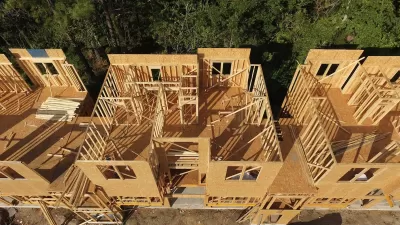Nationwide increases in housing stock since 2020 mirror post-pandemic moving patterns, with six states in the West and South accounting for half of new units.

“The United States has added almost 5 million housing units since 2020, most heavily in the South and most of them single-family homes, making a housing shortage look conquerable in much of the nation,” reports Tim Henderson for Stateline. According to Stateline analysis of Census Bureau data, six states account for 50 percent of the increase: Texas, Florida, California, North Carolina, Georgia, and Tennessee. Last year alone produced the most housing units since 2007.
Henderson notes that the pattern mirrors post-pandemic moving patterns but points out that experts say another 2 to 2.5 million units, mostly single-family homes, are needed. The US has added 1.6 million new units annually for the past two years, according to the Census Bureau data, and that pace is expected to continue.
However, while increased stock may mean cost increases could slow or stabilize, it doesn’t necessarily mean housing prices will come down, as high interest rates continue to hurt potential homebuyers and inflation drives up the cost of building materials and labor. “The Federal National Mortgage Association, known as Fannie Mae, reported last year that the typical homebuyer paid 35% of their income in mortgage payments in October, the highest since at least 2000,” writes Henderson.
States with affected by poverty and low population growth — including Rhode Island, Illinois, West Virginia, Connecticut, Alaska and New Jersey — saw the slowest housing growth, according to Stateline analysis of Census Bureau data.
FULL STORY: Housing boom in most of the US could ease shortage, but cost is still a problem

Maui's Vacation Rental Debate Turns Ugly
Verbal attacks, misinformation campaigns and fistfights plague a high-stakes debate to convert thousands of vacation rentals into long-term housing.

Planetizen Federal Action Tracker
A weekly monitor of how Trump’s orders and actions are impacting planners and planning in America.

In Urban Planning, AI Prompting Could be the New Design Thinking
Creativity has long been key to great urban design. What if we see AI as our new creative partner?

King County Supportive Housing Program Offers Hope for Unhoused Residents
The county is taking a ‘Housing First’ approach that prioritizes getting people into housing, then offering wraparound supportive services.

Researchers Use AI to Get Clearer Picture of US Housing
Analysts are using artificial intelligence to supercharge their research by allowing them to comb through data faster. Though these AI tools can be error prone, they save time and housing researchers are optimistic about the future.

Making Shared Micromobility More Inclusive
Cities and shared mobility system operators can do more to include people with disabilities in planning and operations, per a new report.
Urban Design for Planners 1: Software Tools
This six-course series explores essential urban design concepts using open source software and equips planners with the tools they need to participate fully in the urban design process.
Planning for Universal Design
Learn the tools for implementing Universal Design in planning regulations.
planning NEXT
Appalachian Highlands Housing Partners
Mpact (founded as Rail~Volution)
City of Camden Redevelopment Agency
City of Astoria
City of Portland
City of Laramie





























